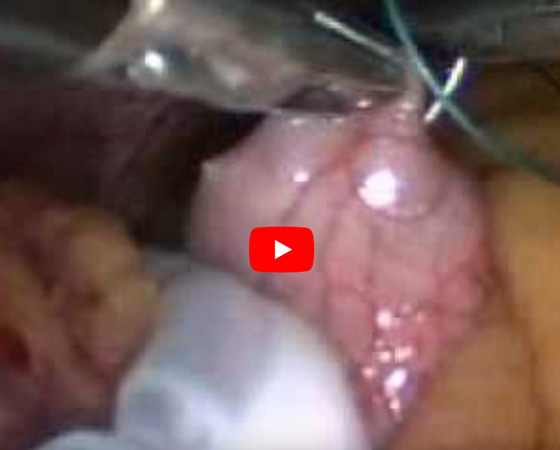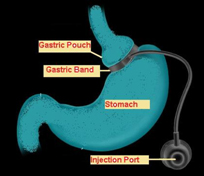Gastric Banding (LAGB)
 Eating after Gastric Band Eating after Gastric Band
 Your Liver Shrinkage diet prior to surgery (Diet Option) Your Liver Shrinkage diet prior to surgery (Diet Option)
 Slimfast Liver Shrinkage Diet Slimfast Liver Shrinkage Diet
Laparoscopic Gastric Band

 Gastric Banding is a purely restrictive surgical procedure or in other words it restricts your ability to eat food. An inflatable band is placed around the uppermost part of your stomach and a tube connects this to a port in your abdominal wall. The band is inflated by injecting fluid into this port, resulting in the creation of a small stomach pouch above the band. The main stomach lies below this pouch and the inflated band guards the channel between these and restricts what can go from the pouch into the stomach and how fast. The pouch normally holds only a mouthful of food and therefore becomes easily distended leading to a early feeling of fullness. The speed at which the pouch empties will be determined by the tightness of the band and when just right will only allow you to eat a small meal (the equivalent of a starter in a restaurant) and make you feel satisfied after it. The band is not inflated at the time of surgery. Your first band fill inflation will be at 4-6 weeks. You will need to have the band tightened from time to time as your weight loss progresses. With this procedure the structure of the stomach and intestines are not altered, so digestion and absorption remains normal. Gastric Banding is a purely restrictive surgical procedure or in other words it restricts your ability to eat food. An inflatable band is placed around the uppermost part of your stomach and a tube connects this to a port in your abdominal wall. The band is inflated by injecting fluid into this port, resulting in the creation of a small stomach pouch above the band. The main stomach lies below this pouch and the inflated band guards the channel between these and restricts what can go from the pouch into the stomach and how fast. The pouch normally holds only a mouthful of food and therefore becomes easily distended leading to a early feeling of fullness. The speed at which the pouch empties will be determined by the tightness of the band and when just right will only allow you to eat a small meal (the equivalent of a starter in a restaurant) and make you feel satisfied after it. The band is not inflated at the time of surgery. Your first band fill inflation will be at 4-6 weeks. You will need to have the band tightened from time to time as your weight loss progresses. With this procedure the structure of the stomach and intestines are not altered, so digestion and absorption remains normal.
Advantages
- Helps improve health problems
- You can expect to lose roughly 30-60 % of your excess weight, provided you follow the dietary advice
- The amount of solid food that can be consumed at a meal is restricted
- Food passes through the digestive tract in the usual order, allowing it to be absorbed fully by the body
- The band can be adjusted to increase or decrease restriction via an access port in your belly wall
- Surgery can be reversed (though you will most likely regain weight)
Disadvantages
- Successful weight loss requires life-long adoption of healthy eating and self-control. The band will fail if you can not give up eating chocolates and sugary drinks
- You may not be able to take tablets or capsules – all medication will have to be in liquid or injection form, at least initially
- You may struggle to eat particular types of food, especially bread and meat
- Weight loss is slower than that following Roux-en-Y gastric bypass surgery and may not start for a number of months after surgery until the band is filled or inflated
- Surgery may not always provide the necessary feeling of fullness - 10% of people fail to lose weight with the band
- The band may move or slip or erode into the stomach wall
- The pouch or gullet above the band may dilate
- The access port may leak or twist, which can require another operation to correct the problem
You will need to have the FREE Adobe Acrobat Reader installed on your system to view this document. Download the Reader by clicking on the Acrobat icon below.

|